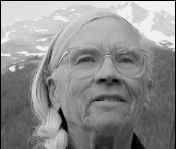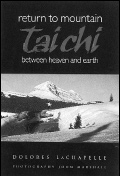|
written by
Missy Votel / photos courtesy Jonathon Thompson
 There
is perhaps no setting more befitting Dolores LaChapelle
than her simple wood cabin nestled on a snow-packed Silverton
street. Wearing an Outward Bound T-shirt and a long, plaid
wool skirt with her signature braid – now a brilliant
silver – hanging loosely down her back, she sits
in a sunny nook, surrounded by mountains. Out the window
behind her, the sun is setting over Sultan. To her right,
Kendall looms. On its shadowed lower flanks, a lone skier
rides the town’s rope tow. There
is perhaps no setting more befitting Dolores LaChapelle
than her simple wood cabin nestled on a snow-packed Silverton
street. Wearing an Outward Bound T-shirt and a long, plaid
wool skirt with her signature braid – now a brilliant
silver – hanging loosely down her back, she sits
in a sunny nook, surrounded by mountains. Out the window
behind her, the sun is setting over Sultan. To her right,
Kendall looms. On its shadowed lower flanks, a lone skier
rides the town’s rope tow.
Before the interview can commence, LaChapelle lays down
the rules. Whoever sits in the west-facing seat must don
sunglasses to shield her eyes from the glare.
I dutifully fish mine out, however unconventional the
request may be, thankful for the reprieve from the late-afternoon
rays.
Outside, the snowbanks have already reached respectable
heights, thanks to the most recent storm that dropped
about a foot of snow on the town. Inside, LaChapelle is
reading a paper and shaking her head in disapproval.
“Seventy-one dollars to ski at Vail,” she
says in disgust. And while the price is steep, the veteran
skier admits the steep price won’t keep her away,
“I wouldn’t ever ski Vail anyway,” she
says.
If she sounds disdainful, it’s for good reason.
LaChapelle spent the better part of five decades skiing,
or more specifically in pursuit of the purism offered
by untracked powder. In fact, she knows the subject so
well, she published a book, Deep Powder Snow, on it in
1993.
The septuagenarian not only knows skiing history, she
has lived it. When Aspen fired up its first chairlift,
she was there. When Alta, Utah, was but a tiny speck on
the map, she was there, too.
Wooden skis? She had them. Avalanches? Survived those,
too. She will also tell you how many of the places she
loved have been ruined by commercialism and greed. And
now, she watches with a knowing eye as more development
is about to take place down the road from her home of
30 years.
“They’re going to develop that whole corridor,”
she says of the swath of mostly empty land between Durango
Mountain Resort and Cascade Village. “I guess you
knew it had to happen some day.”
Originally from Denver, LaChapelle cut her teeth skiing
Loveland Pass on a pair of World War II Army surplus boards.
In 1947, she graduated college early with the intent of
finding a teaching job in a mountain town and landed in
Aspen. And although today the former mining enclave is
synonymous with wealth and glitz, LaChapelle says the
old Aspen was anything but.
“They had just built the lift,” she said.
“It was before skiing became fashionable. At the
time skiing was not a big money-maker. I know it seems
bizarre, but everyone was just there to ski.”
LaChapelle took advantage of cheap ski lessons and soon
found herself not only teaching skiing but hiking the
steeps of Bell Mountain (which at the time was not lift
served) in search of untracked powder. It was during her
third and final year in Aspen that she started a correspondence
with Ed LaChapelle, whom she met on a summer climbing
trip in Canada. A year later, the two married, and Ed’s
work as an avalanche researcher took the couple to the
Swiss Alps.
The change couldn’t have come at a better time for
LaChapelle, who says she sensed the carefree days of Aspen
coming to an end. She said people had begun to realize
money could be made in skiing and were taking over the
small town.
And while a chapter in skiing history had closed, in her
eyes, another had just opened: the invention of metal
skis.
“Howard Head ruined skiing,” LaChapelle said,
partly in jest. Much like the shaped skis of today, LaChapelle
said the 1950 introduction of wood-core metal skis (the
predecessors were made of solid wood) revolutionized the
sport – and not necessarily for the better.
“Now anyone could ski,” she said.
After the stint in Europe, Ed’s job eventually landed
the couple in Alta, which they called home for the next
20 years.
“The greatest snow on Earth,” LaChapelle says,
well aware she may sound like a “Ski Utah”
billboard. “But it’s true,” she insists.
During the ensuing seasons at Alta, which included many
brushes with avalanches, including one that left her hospitalized
in a body cast, LaChapelle became renowned in skiing circles
for her powder skiing prowess. She even earned the nickname
“Witch of the Wasatch” for her uncanny ability
to predict storms. However, much like her tenure in Aspen,
the good times at Alta came to an end with the opening
of Snowbird in the early ’70s. Knowing that all
of Ed’s time would be taken up with control work
rather than his true love – research – the
couple packed their bags, this time headed for the San
Juans.
Although LaChapelle admits it was hard to say good-bye
to Alta’s famous fluff in favor of the equally infamous
San Juan cement, she said there was enough terrain and
powder surrounding her new home to survive. In fact, it
could be said that she even thrived – becoming a
regular fixture in the backcountry ski scene. She even
pioneered a ski descent of a gully near Sam’s, a
popular backcountry shot near the abandoned enclave of
Chattanooga. Nevertheless, LaChapelle dismisses the recurring
suggestion that she was the first female extreme skier.
“I’m not extreme. No way,” she says.
“I was the best female powder skier, but there was
nothing extreme about it.”
In fact, the competitive nature of extreme skiing runs
precisely counter to LaChapelle’s entire theory
of skiing and life in general. If anything, LaChapelle
was one of the first female soul skiers.
For her, skiing wasn’t about conquering the mountain,
she says, but surrendering herself fully to the forces
of gravity, rock and snow. She always realized that her
love of powder went deeper than an entertaining hobby
or pastime. Rather, it gave her a unique connection to
the world. It was an escape from what she refers to as
the “rational hemisphere,” the part of the
brain that constantly seeks reason.
“Anything that gets you out of the rational hemisphere
is good,” she says. “And skiing does that,
as long as you’re not out to prove something or
how good you are.”
However, it wasn’t until many years later, when
California philosophy professor Paul Shepard coined the
phrase “Deep Ecology” that LaChapelle had
a name to attach to her concept.
 She
immediately became an advocate of Deep Ecology, which
espouses the virtue of humans living in harmony with nature,
and once again found herself at the forefront of a revolution.
Today, Deep Ecology is a worldwide environmental movement
that counts famous redwood-sitter Julia Butterfly among
its followers. LaChapelle has written several books on
the subject, which are standard reading in many college
courses, and has traveled the world lecturing on the subject. She
immediately became an advocate of Deep Ecology, which
espouses the virtue of humans living in harmony with nature,
and once again found herself at the forefront of a revolution.
Today, Deep Ecology is a worldwide environmental movement
that counts famous redwood-sitter Julia Butterfly among
its followers. LaChapelle has written several books on
the subject, which are standard reading in many college
courses, and has traveled the world lecturing on the subject.
Yet, despite her fame and success, LaChapelle actually
shuns the limelight, preferring the isolation of Silverton.
“I try to hide out here so people can’t find
me,” she says.
And to make it even more difficult, she has no Internet,
no fax machine and no TV.
“I have enough people calling for interviews, and
I have plenty to keep me busy,” she said. “If
I had all that I’d go crazy.”
This is not to say that LaChapelle prefers to stick her
head in the snow, oblivious to the world around her. Quite
the contrary, she has a voracious appetite for reading
(or “finding answers” as she calls it.) The
walls in her house are lined with books, and she gets
up from the interview no less than three times to fetch
various works to refer to.
And although she gave up skiing 10 years ago because of
a hip injury (a lasting reminder of the Alta avalanche)
LaChapelle stays physically active as well. She has a
pair of snowshoes for touring the backcountry and is a
devout practitioner of tai chi, which she teaches once
a week.
She has penned a book on tai chi as well, Return to Mountain:
Tai Chi Between Heaven and Earth, which is due in stores
any day. It will be LaChapelle’s seventh book, nevertheless,
she is reluctant to call herself a writer, preferring
the term “information dispenser.”
“I didn’t want to be a writer,” she
says. “I was just trying to save the world, but
now I think there’s no hope.”
Yet, there is something about this woman, who has endured
7-foot wooden skis, several avalanches and a lifetime
of mountain living, that tells you she is not about to
give up the fight.
In fact, she admits that if there is any hope, it will
come through practice of this ancient form of martial
art.
“All you need is a little outdoors, and you do it
every day,” she said. “Eventually you will
fall in love with the place where you do it, and you’ll
do anything to save it.”
A constant reminder of what she’s working toward
is propped up in her house, near the front door for all
to see. It is the top portion of a log from South Mineral
Creek, split down the middle by lightning and worn smooth
as marble by years of human passage. LaChapelle herself
has used the log many a time to cross the stream. When
she noticed the bottom was rotting away, she lugged home
the top, which is now a banister.
“What I’m seeing there is hope,” she
admitted while rubbing her weathered but strong hands
along the well-polished surface, “humans and nature
working together to make something beautiful.”
|

